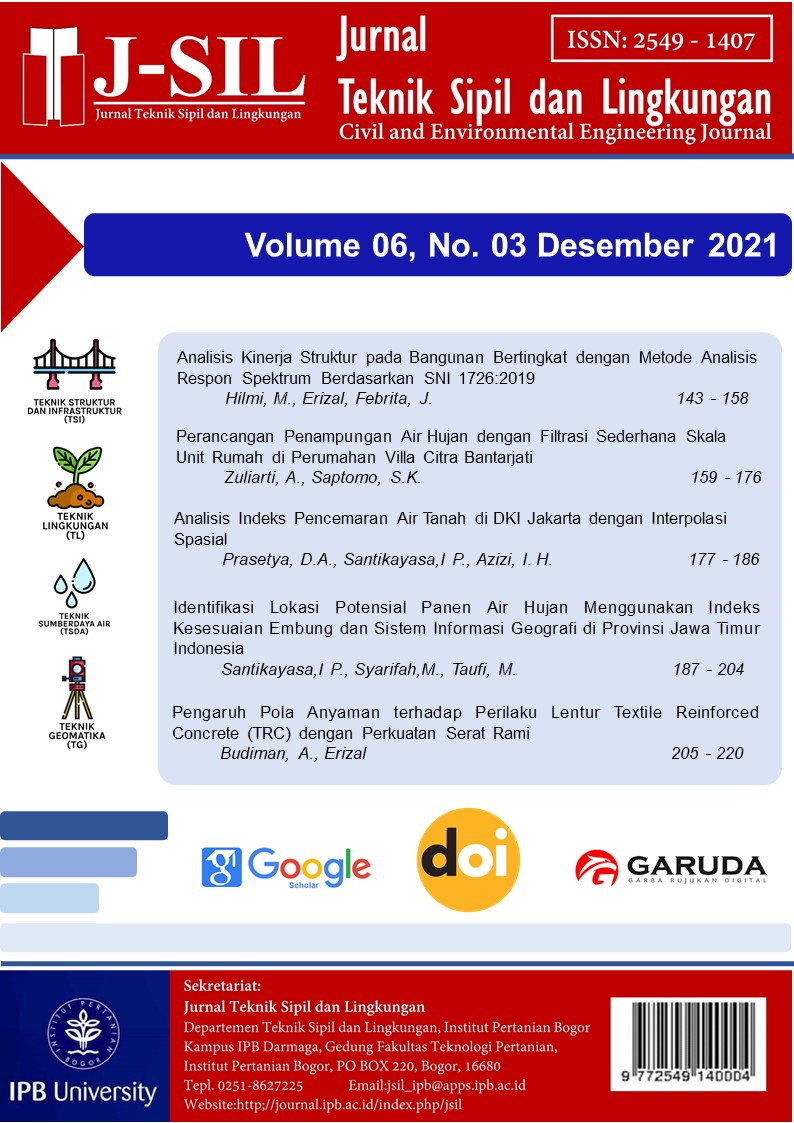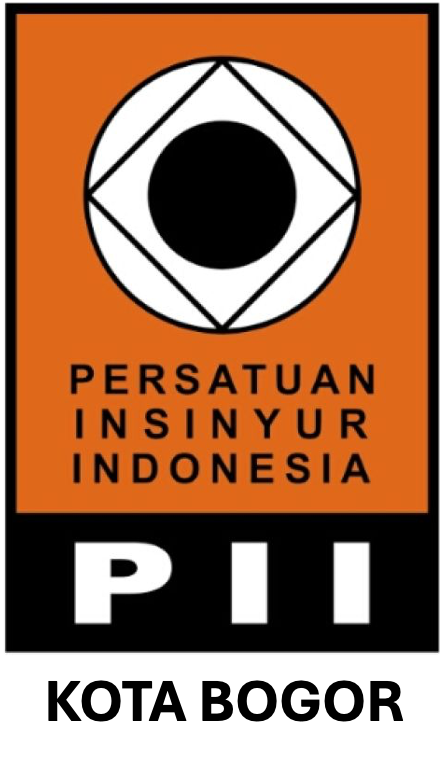Identifikasi Lokasi Potensial Panen Air Hujan Menggunakan Indeks Kesesuaian Embung dan Sistem Informasi Geografi di Provinsi Jawa Timur Indonesia
Identification of Locations for Potential Rainwater Harvesting Using the Conformity Index of Embankments and Geographic Information Systems in East Java Province, Indonesia
Abstract
Increasing population has an impact on increasing food supply to fulfil the requirement of the community. Increasing in food supply is able to be achieved by increasing the agricultural productive area. Low-water agricultural technology is one of technology can be applied in the development of agricultural areas with sufficient water availability. But on the other hand, water harvesting technology using pond is one approach in the development of agricultural land in dry areas. This study uses a geographic information system (GIS) approach to identify areas that have high potential for the development of water harvesting ponds in East Java Province, Indonesia. GIS approaches is used for spatial analysis in calculating the area potential index for the ponds deveopment based on climate, physical surface and vegetation indicators. This index is calculated based on indicators, each of which is obtained from the surface parameter data. The results of the study show that the East Java Province is categorized as the "very suitable" and "appropriate" areas on water harvesting ponds suitability by 55% and 23%, respectively. This results show that the potential of the East Java area for developing water harvesting pond is very high about 78% compared with the entire region. On the other hand, locations that is categorized as "not suitable" and "very inappropriate" are about 8.7% and 9.2% compared with total area of East Java Province. Iit can be concluded that climate, physical surface and vegetation indicators are very important in determining the locations of water harvesting ponds development in East Java Province.
Downloads
References
Adi, H. P. (2011). Kondisi dan konsep penanggulangan bencana kekeringan di Jawa Tengah. Seminar Nasional Mitigasi Dan Ketahanan Bencana, 26, 1–10.
Adrianto, H. (2017). Lumbung Air sebagai Alternatif Penyediaan Air Baku Perkotaan (Studi Kasus: Analisis Penentuan Prioritas Lokasi Embung). Prosiding Seminar Nasional Inovasi Dalam Pengembangan SmartCity, 1(1).
Ammar, A., Riksen, M., Ouessar, M., & Ritsema, C. (2016). Identification of suitable sites for rainwater harvesting structures in arid and semi-arid regions: A review. International Soil and Water Conservation Research, 4(2), 108–120.
Anam, K., Munibah, K., & Sudadi, U. (2020). Strategi Pengembangan Lahan Budidaya Jagung dan Padi di Wilayah Daratan Kabupaten Sumenep, Madura, Jawa Timur. Jurnal Ilmu Tanah Dan Lingkungan, 22(2).
Anjasmoro, B., Suharyanto, S., & Sangkawati, S. (2016). Analisis Prioritas Pembangunan Embung Metode Cluster Analysis, AHP dan Weighted Average (Studi Kasus: Embung di Kabupaten Semarang). Media Komunikasi Teknik Sipil, 21(2), 101–112.
Budianto, M. B., Supriadi, A., Hidayat, S., & Salehudin, S. (2020). Model Irigasi Hemat Air Perpaduan System of Rice Intensification (SRI) dengan Alternate Wetting and Drying (AWD) pada Padi Sawah. Jurnal Teknik Pengairan: Journal of Water Resources Engineering, 11(2), 128–136.
Djamhari, S. (2009). Peningkatan produksi padi di lahan lebak sebagai alternatif dalam pengembangan lahan pertanian ke luar pulau Jawa. Jurnal Sains Dan Teknologi Indonesia, 11(1).
Ginting, S., Rahmandani, D., & Indarta, A. H. (2019). Optimasi pemanfaatan air embung Kasih untuk domestik dan irigasi tetes. Jurnal Irigasi, 13(1), 41–54.
Harini, R., Ariani, R. D., Supriyati, S., & Satriagasa, M. C. (2019). Analisis Luas Lahan Pertanian Terhadap Produksi Padi Di Kalimantan Utara. Jurnal Kawistara, 9(1), 15–27.
Hermawan, A., Purwanto, M. Y. J., & Pandjaitan, N. H. (2020). Analisis Kesesuaian Lokasi Bendung Kecil dan Daerah Pemanenan Air Hujan (PAH) dengan Menggunakan Sistem Informasi Geogerafis (SIG) di Wilayah Perkotaan. TATALOKA, 22(2), 188–201.
Iglesias, A., & Garrote, L. (2018). Local and collective actions for adaptation to use less water for agriculture in the mediterranean region. In Water scarcity and sustainable agriculture in semiarid environment (pp. 73–84). Elsevier.
Indriani, Y., Limantara, L. M., & Soetopo, W. (2020). Analisis Optimasi Untuk Prioritas Pembangunan Embung Berbasis Ketersediaan Air Di Kecamatan Kedungadem Kabupaten Bojonegoro. Jurnal Teknik Pengairan: Journal of Water Resources Engineering, 11(2), 94–103.
Krisnayanti, D. S. (2018). Analisis nilai koefisien limpasan permukaan pada embung kecil untuk pertanian di pulau flores bagian timur. JURNAL SUMBER DAYA AIR, 14(2), 125–140.
Mahendra, D. D., & Noerhayati, E. (2019). Studi Perencanaan Embung Kalipang Kabupaten Pasuruan Propinsi Jawa Timur. Jurnal Rekayasa Sipil, 6(1), 63–75.
Maryantika, N., Jaelani, L. M., & Setiyoko, A. (2018). Analisa Perubahan Vegetasi Ditinjau Dari Tingkat Ketinggian Dan Kemiringan Lahan Menggunakan Citra Satelit Landsat Dan SPOT 4 (Studi Kasus Kabupaten Pasuruan). Geoid, 7(1), 94–100.
Misnawati, M., Firda, D., & Rachmawati, N. (2020). Potensi Tanam Padi pada Musim Kemarau 2020 di Provinsi Jawa Timur. Buletin Hasil Penelitian Agroklimat Dan Hidrologi, 17, 47–59.
Muslim, A. (2017). Prospek Ekonomi Ubi Kayu di Indonesia. Repositori Universitas Al Azhar Indonesia. Jakarta: UAI. Downloaded Fom: Http://Repository. Uai. Ac. Id/Wpcontent/Uploads/2017/10/Prospek-Ekonomi-Ubi-Kayu-Di-Indonesia. Pdf.
Nasution, M. I., & Nuh, M. (2019). Kajian Iklim berdasarkan Klasifikasi Oldeman di Kabupaten Langkat. JISTech (Journal of Islamic Science and Technology), 3(2).
Prabowo, A., Arif, S. S., Sutiarso, L., & Purwantana, B. (2014). Model simulasi pengembangan sistem irigasi untuk tanaman jagung di lahan sawah dan lahan kering (studi kasus pada usahatani jagung di Kabupaten Kediri). Agritech, 34(2), 203–212.
Priyoadi, B. R., & Setiawan, B. I. (2020). Pemetaan Topografi Calon Lokasi Embung di Kampus IPB Darmaga, Bogor. Jurnal Teknik Sipil Dan Lingkungan, 5(1), 51–58.
Quist-Jensen, C. A., Macedonio, F., & Drioli, E. (2015). Membrane technology for water production in agriculture: Desalination and wastewater reuse. Desalination, 364, 17–32.
Rahayu, N. D., Sasmito, B., & Bashit, N. (2018). Analisis pengaruh fenomena indian ocean dipole (IOD) terhadap curah hujan di pulau Jawa. Jurnal Geodesi Undip, 7(1), 57–67.
Salli, M. K. (2019). Penerapan Teknologi Hemat Air Pada Budidaya Tanaman Semusim Lahan Kering Di Desa Baumata Timur Kabupaten Kupang. J-Dinamika: Jurnal Pengabdian Masyarakat, 4(1).
Santikayasa, I. P., Maesaroh, S., & Agis. (2017). Water Allocation Based on Economic Criteria Using Aquarius Model (A Case Study in Ambang-Brantas subbasin, Indonesia). Agromet, 31(2), 89–102.
Santoso, A. B. (2015). Pengaruh luas lahan dan pupuk bersubsidi terhadap produksi padi nasional. Jurnal Ilmu Pertanian Indonesia, 20(3), 208–212.
Sitanggang, R. S. H., Wahyudi, K., & Tafonao, P. (n.d.). ANALISIS HUBUNGAN KETINGGIAN TEMPAT DENGAN JENIS DAN KLASIFIKASI FLORA DI WILAYAH HUTAN SIBOLANGIT. Tunas Geografi, 6(2), 124–130.
Sitompul, M., & Efrida, R. (2018). Evaluasi Ketersediaan Air Das Deli Terhadap Kebutuhan Air (Water Balanced). Jurnal Rekayasa Sipil (JRS-Unand), 14(2), 121–130.
Soerjandono, N. B. (2019). TEKNIK PENGKAJIAN VARIETAS UNGGUL BARU PADI GOGO DI LAHAN MARGINAL. Penanggung Jawab, 24(1), 53–56.
Subagyono, K., Haryati, U., & Tala’ohu, S. H. (2004). Teknologi konservasi air pada pertanian lahan kering. Dalam: Kurnia U, Rachman A, Dariah A (Eds.). Teknologi Konservasi Tanah Pada Lahan Kering Berlereng. Puslitbang Tanah Dan Agroklimat, Badan Litbangtan, 151–188.
Sudana, W. (2017). Potensi Dan Prospek Lahan Rawa Sebagai Sumber Produksi Pertanian. Potensi Dan Prospek Lahan Rawa Sebagai Sumber Produksi Pertanian, 3(2), 141–151. https://doi.org/10.21082/akp.v3n2.2005.141-151
Suprayogi, I., Asmura, J., & others. (2017). PEMANFAATAN PEMANENAN AIR HUJAN SKALA INDIVIDU UNTUK KEBUTUHAN AIR BERSIH PADA PULAU KECIL. Logic: Jurnal Rancang Bangun Dan Teknologi, 17(1), 9–15.
Sutrisno, N., & Heryani, N. (2019). Pengembangan irigasi hemat air untuk meningkatkan produksi pertanian lahan kering beriklim kering. Jurnal Sumberdaya Lahan, 13(1), 17–26.
Tala’ohu, S. H., Heryani, N., & Sudarman, K. (2013). Kondisi Biofisik Lahan Serta Arahan Teknik Konservasi Tanah Dan Air Pada Beberapa Embung Di Nusa Tenggara Timur. Bogor: Balai Penelitian Agroklimat dan Hidrologi.
Taufik, M., Kurniawan, A., & Putri, A. R. (2016). Identifikasi Daerah Rawan Tanah Longsor Menggunakan SIG (Sistem Informasi Geografis)(Studi Kasus: Kabupaten Kediri). Jurnal Teknik ITS, 5(2), C78--C82.
Tumbo, S. D., Mbilinyi, B. P., Mahoo, H. F., & Mkilamwinyi, F. O. (2013). Identification of suitable indices for identification of potential sites for rainwater harvesting. Tanzania Journal of Agricultural Sciences, 12(2).
Ulfah, A., & Sulistya, W. (2015). Penentuan kriteria awal musim alternatif di wilayah Jawa Timur. Jurnal Meteorologi Dan Geofisika, 16(3).
Winahyu, N. (2020). Analisis Penentuan Komoditas Unggulan Tanaman Pangan Di Kabupaten Kediri Provinsi Jawa Timur. Jurnal Ilmiah Hijau Cendekia, 5(2), 51–54.
Copyright (c) 2021 J-Sil (Jurnal Teknik Sipil dan Lingkungan)

This work is licensed under a Creative Commons Attribution-NonCommercial-NoDerivatives 4.0 International License.
Authors who publish with Jurnal Teknik Sipil dan Lingkungan, JSIL agree to the following terms:
a. Authors retain copyright and grant the journal right of first publication with the work simultaneously licensed under a Creative Commons Attribution License that allows others to share the work with an acknowledgment of the work's authorship and initial publication in this journal.
b. Authors are able to enter into separate, additional contractual arrangements for the non-exclusive distribution of the journal's published version of the work (e.g., post it to an institutional repository or publish it in a book), with an acknowledgment of its initial publication in this journal.
c. Authors are permitted and encouraged to post their work online (e.g., in institutional repositories or on their website) prior to and during the submission process, as it can lead to productive exchanges, as well as earlier and greater citation of published work (See The Effect of Open Access).











